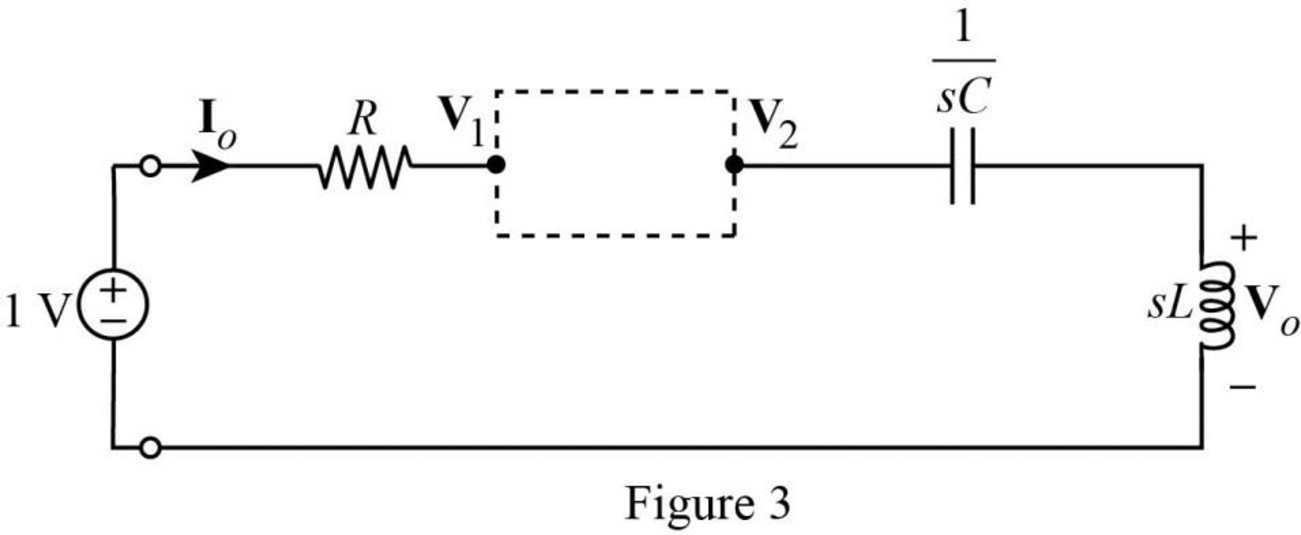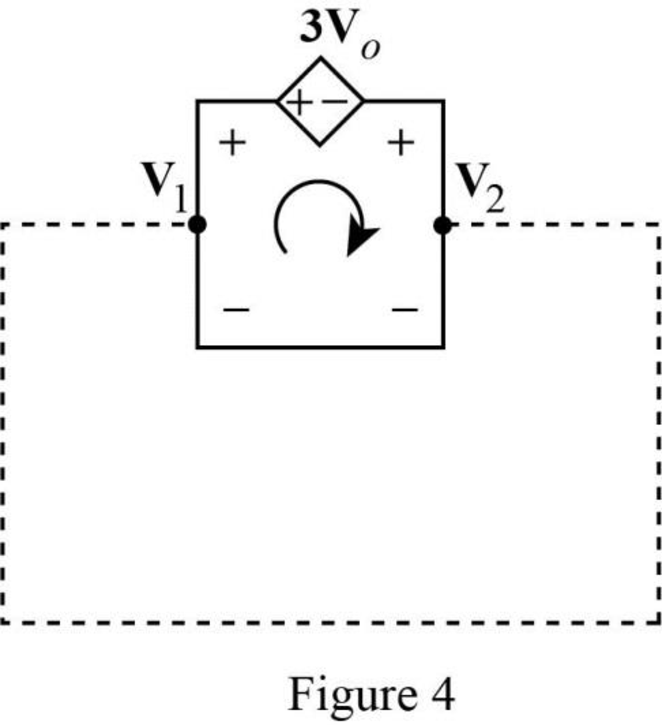
Concept explainers
Refer to the network in Fig. 14.96.
- (a) Find Zin(s).
- (b) Scale the elements by Km = 10 and Kf = 100. Find Zin(s) and ω0.

Figure 14.96
(a)
Find the value of the input impedance
Answer to Problem 79P
The value of the input impedance
Explanation of Solution
Given data:
Refer to Figure 14.96 in the textbook.
Formula used:
Write the expression to calculate the impedance of the passive elements resistor, inductor and capacitor in s-domain.
Here,
Calculation:
The given circuit is redrawn as Figure 1.

Use equation (1) to find
Use equation (1) to find
Use equation (2) to find
Use equation (3) to find
Insert a

Modify the Figure 2 with the representation of supernode and current direction as shown in Figure 3.

Apply Kirchhoff’s current law to the supernode in Figure 3.
The Figure 3 is reduced as following Figure 4 to show the voltage relation.

Apply Kirchhoff’s voltage law to the circuit in Figure 4 to obtain the relationship between voltages.
Apply voltage division rule on Figure 3 to find
Rearrange the above equation.
Rearrange the equation (6) to find
Substitute
Rearrange the above equation to find
Compare the equations (4) and (6) to obtain the following equation.
Substitute
Rearrange the above equation.
Simplify the above equation to find
Refer to Figure 3, the current
Substitute
The input impedance of the circuit in Figure 2 is calculated as follows.
Substitute
Substitute
Substitute
At resonance condition, the imaginary part of the impedance should be equal to zero. Therefore, equate the imaginary part of the above equation to zero.
Simplify the above equation to find
Take square root on both sides of the above equation to find
Substitute
Conclusion:
Thus, the value of the input impedance
(b)
Find the value of the input impedance
Answer to Problem 79P
The value of the input impedance
Explanation of Solution
Given data:
The value of the magnitude scaling factor
The value of the frequency scaling factor
Formula used:
Consider the equations used in magnitude and frequency scaling.
Write the expression to calculate the scaled resistor.
Here,
Write the expression to calculate the scaled inductor.
Here,
Write the expression to calculate the scaled capacitor.
Calculation:
Substitute
Substitute
Substitute
Substitute
Substitute
Conclusion:
Thus, the value of the input impedance
Want to see more full solutions like this?
Chapter 14 Solutions
FUND.OF ELECTRIC CIRCUITS>CUSTOM<
- A supply voltage of 3 V is applied to a series R–L–C circuit whose resistance is 12 ohms , inductance is 7.5 mH and capacitance is 0.5µF. Determine (a) the current flowing at resonance, (b) the current flowing at a frequency 2.5% below the resonant frequency and (c) the impedance of the circuit when the frequency is 1% lower than the resonant frequency.arrow_forwardA coil with R=7.7 Ohms and L=23.7 mH, is in parallel with a 3.87 mF capacitance. Calculate the impedance at resonance (in ohms)?arrow_forwardCompute the frequency at which the output of the given circuit is attenuated by 10 percent (that is, Vo = 0.9Vi). Given: R = 1.4 kohm, C = 0.47 μF, and vi(t) = 5cos(ωt) Varrow_forward
- Solve by Routh,array test. Gp= 1/(S^3+3S^2+3s+1),Gc=Kc,Gm=1arrow_forwardA circuit consists of an inductor which has a resistance of 10 Ω and an inductance of 0.3 H, in serieswith a capacitor of 30 μF capacitance. Calculate(a) the impedance of the circuit to currents of 40 Hz (b) the resonant frequency (c) the peakvalue of stored energy in joules when the applied voltage is 200 V at the resonant frequency.Answer: [58.31 Ω; 53 Hz; 120 J]arrow_forwardAn AC series circuit has a resistance of 10 ohms, and inductance of 0.2 H, and a capacitance of 60 micro Farad. Calculate: (a) the resonant frequency, (b) thecurrent, and (c) the power at resonance. Given that the applied voltage is 200 V. draw the circuit diagramarrow_forward
- all in parallel, a resister 4ohm, inductor 40mH and a capacitor 30nF, (1) derive the impedance and admittance functions in terms of frequency. (2) Calculate the numerical values of the resonant frequency, the dynamic impredance and bandwidtharrow_forwardUse the image below to help answers parts a and b.in an LRC type circuit series the inductive reactance is XL=484 ohms. and I=0.8 amps is the measured current amplitude.A) In the inductor determine the amplitude of the voltage.B)If the LRC circuit is at resonance frequency find the capacitive reactance.arrow_forwardG(s)=150(6.25s+1)(s+7)/[s(46.875s+1)(s+5)(s+15)] Draw bode plot using straight linearrow_forward
- Hi, can you please draw a stright line bode aproximation for the equation attached. On the graph include individual componentsarrow_forwardA coil of resistance 25Ω and inductance 100mH is connected in series with a capacitance of 0.12μF across a 200V, variable frequency supply. Calculate: i. The resonant frequency. ii. The current at resonance. iii. The factor by which the voltage across the reactance is greater than the supply voltage.arrow_forward388 / 5000 Çeviri sonuçları In the circuit in the figure, Rs = 3.8 kΩ, R1 = 82 kΩ, R2 = 22 kΩ, RC = 5.6 kΩ, RE = 1.5 kΩ and RL = 3.3 kΩ and β = 150.Since the capacitances are C1 = 0.5 μF and C2 = 0.53 μF, what is the low cutoff frequency of the given circuit? NOTE-1: In the middle band frequency, β = 150 will be taken and the frequency dependence of β will not be taken into account. NOTE-2: The output impedance of the transistor r0 will be neglected in the calculations.arrow_forward
 Introductory Circuit Analysis (13th Edition)Electrical EngineeringISBN:9780133923605Author:Robert L. BoylestadPublisher:PEARSON
Introductory Circuit Analysis (13th Edition)Electrical EngineeringISBN:9780133923605Author:Robert L. BoylestadPublisher:PEARSON Delmar's Standard Textbook Of ElectricityElectrical EngineeringISBN:9781337900348Author:Stephen L. HermanPublisher:Cengage Learning
Delmar's Standard Textbook Of ElectricityElectrical EngineeringISBN:9781337900348Author:Stephen L. HermanPublisher:Cengage Learning Programmable Logic ControllersElectrical EngineeringISBN:9780073373843Author:Frank D. PetruzellaPublisher:McGraw-Hill Education
Programmable Logic ControllersElectrical EngineeringISBN:9780073373843Author:Frank D. PetruzellaPublisher:McGraw-Hill Education Fundamentals of Electric CircuitsElectrical EngineeringISBN:9780078028229Author:Charles K Alexander, Matthew SadikuPublisher:McGraw-Hill Education
Fundamentals of Electric CircuitsElectrical EngineeringISBN:9780078028229Author:Charles K Alexander, Matthew SadikuPublisher:McGraw-Hill Education Electric Circuits. (11th Edition)Electrical EngineeringISBN:9780134746968Author:James W. Nilsson, Susan RiedelPublisher:PEARSON
Electric Circuits. (11th Edition)Electrical EngineeringISBN:9780134746968Author:James W. Nilsson, Susan RiedelPublisher:PEARSON Engineering ElectromagneticsElectrical EngineeringISBN:9780078028151Author:Hayt, William H. (william Hart), Jr, BUCK, John A.Publisher:Mcgraw-hill Education,
Engineering ElectromagneticsElectrical EngineeringISBN:9780078028151Author:Hayt, William H. (william Hart), Jr, BUCK, John A.Publisher:Mcgraw-hill Education,





